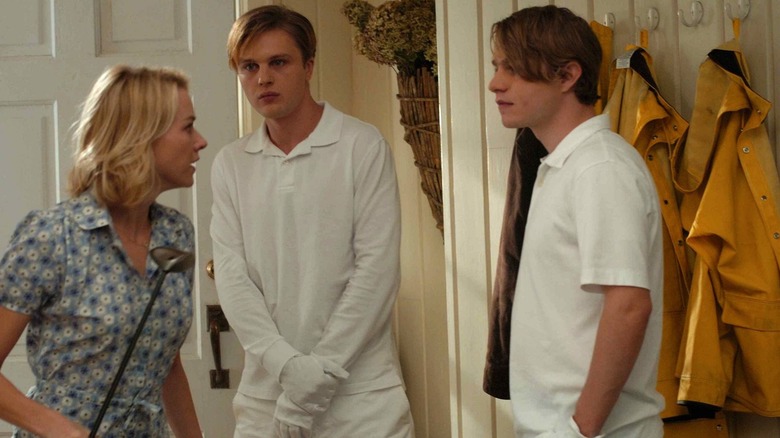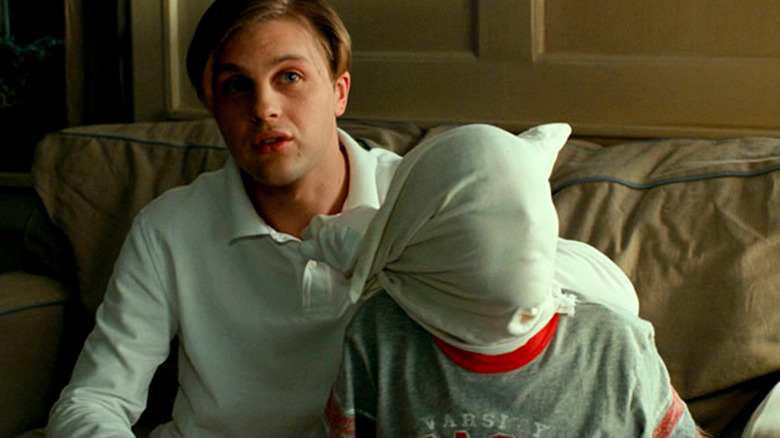This Naomi Watts Horror Movie Was Actually A Remake From The Same Director
In 1997, Austrian provocateur Michael Haneke made "Funny Games," one of the scariest and most confrontational films of its decade. "Funny Games" follows the plight of a placid, upper-class family of three (Susanne Lothar, Ulrich Mühe, Stefan Clapczynski) as they trek to their lakeside cabin for a miniature vacation. As they are settling in, they receive a visit from two creepy young men in tennis whites and gloves, asking to borrow some eggs. The young men are Paul (Arno Firsch) and Peter (Frank Giering), and they clearly have a dark agenda.
As soon as matriarch Anna asks them to leave, Peter and Paul snatch a golf club and begin inflicting injuries. They reveal they have already killed the family dog, and that the remaining family members are not allowed to leave. Peter and Paul tie them up and announce they are going to play some games. These funny games involve torture, mockery, and death. At one point, Paul turns to the camera and asks the audience if the Schober family has a chance at survival. It won't be the last time that "Funny Games" breaks the fourth wall.
Without revealing what happens, "Funny Games" doesn't end well. Haneke, though, isn't just making a run-of-the-mill home-invasion thriller. He is torturing the audience, rather deliberately. Haneke points out to viewers, while they are watching the movie, that they are the ones responsible for the pain they are witnessing. In watching the horrors, you are longing for blood. Do you want to see the torturers get their violent comeuppance instead? Isn't that just more audience bloodlust, Haneke asks? He is implicating you. He is making a comment on the use of violence in cinema.
And his thesis became clearer in 2007 when Haneke made essentially a shot-for-shot remake of "Funny Games" in English with recognizable English-speaking stars. Naomi Watts played the mother, Tim Roth the father, and the torturers were played by Michael Pitt and future "The Brutalist" director Brady Corbet.
Both versions of Funny Games are excellent
In the original, he strings the audience along, constructing what looks like — at least at first — a run-of-the-mill horror movie. Such horror movies usually involve the innocent being harmed, and audiences know that. Haneke has his killers peer directly at the audience, declaring that it is they, and not the victims, that we're meant to identify with. You came to see torture? Here it is. You, dear viewer, are the sick one. You are the evil one. You are killing this family.
We, left with that implication, begin to look for just, explainable reasons why the central family is being so grievously punished. Is it because they are rich and bougie? That makes sense, as their killers are dressed in tennis outfits, a uniform of the bourgeoisie. Paul and Peter are initially polite, but also weirdly critical of the Schober family. They break the eggs they are borrowing "by accident," and then ask for more. Are they testing the limits of the Schober family's politeness? Are the Schobers being tortured for not properly weathering this little test of politeness?
And, wait, aren't we being a little sick just by asking these questions? Surely, then, the thesis of "Funny Games" is to achieve catharsis in witnessing the torturers facing justice, right? If the family can escape, get the drop on their captors, and achieve blood revenge, we, the audience, can rest assured that justice is served. Sometimes, we can say comfortably to ourselves, violence is necessary to balance the scales.
But then, Haneke doesn't let us have that either. The killers can break the fourth wall, so they have total mastery over the movie itself. Even longing for their deaths is revealing our own need for violence. There's no way out for us. We, us, the viewers. We are the guilty party.
The American version of Funny Games is more pointed
In remaking "Funny Games" in English, Haneke narrowed the theme of his first movie to a more cutting degree. In the 1997 original, the director is commenting on the function violence in cinema serves. For him, it is all harsh, and we, as audience members, rarely acknowledge the safety the movie screen offers us. When the violence is fake, we can distance ourselves from it, shut off large parts of our empathy. Human beings can compartmentalize anything.
But in 2007, there was an additional layer of commentary. Haneke is now making a film in English for an American audience. He is casting recognizable stars as his torture victims, and releasing his film in a greater number of theaters than his original ever saw. The 2007 film was a comparatively mainstream release. The commentary, then, now applies more specifically to violence in mainstream American movies. Haneke is not just implicating a cinema audience in the on-screen violence, but Americans specifically.
In 2007, recall, torture films were very much in fashion. 2007 was the same year as "Saw IV," for instance. Americans were processing their trauma over 9/11 — not to mention the real-life prison torture photos coming out of Abu Ghraib — by watching torture on-screen. We were taking the curse off of real-life violence by indulging in the fictional variety. It was a bleak form of therapy. Michael Haneke, born in Austria, wasn't going to allow Americans to use his movie to purge themselves of violent ideas. He was going to shove it in our faces. You want violence? You're going to get it. And if it's disturbing or awful, well, that's kind of on you, isn't it?
Both versions of "Funny Games" are excellent, as they are largely identical.


